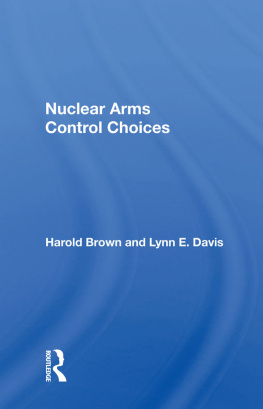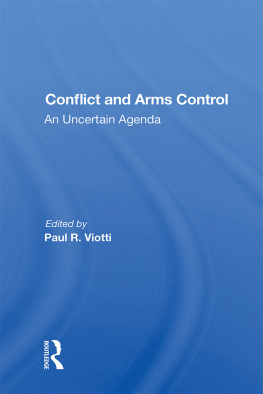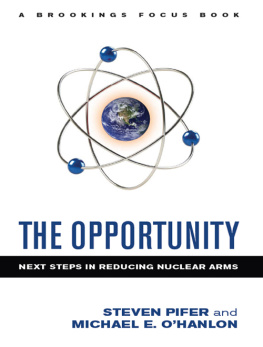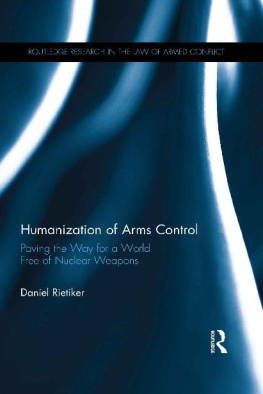SAIS PAPERS IN INTERNATIONAL AFFAIRS
Nuclear Arms Control Choices
SAIS PAPERS IN INTERNATIONAL AFFAIRS
NUMBER 5
Nuclear Arms Control Choices
Harold Brown and Lynn E. Davis
First published 1984 by Westview Press, Inc.
Published 2018 by Routledge
52 Vanderbilt Avenue, New York, NY 10017
2 Park Square, Milton Park, Abingdon, Oxon OX14 4RN
Routledge is an imprint of the Taylor & Francis Group, an informa business
Copyright 1984 by The Johns Hopkins Foreign Policy Institute, School of Advanced International Studies
All rights reserved. No part of this book may be reprinted or reproduced or utilised in any form or by any electronic, mechanical, or other means, now known or hereafter invented, including photocopying and recording, or in any information storage or retrieval system, without permission in writing from the publishers.
Notice:
Product or corporate names may be trademarks or registered trademarks, and are used only for identification and explanation without intent to infringe.
ISBN 13: 978-0-367-01999-0 (hbk)
The Johns Hopkins Foreign Policy Institute
Harold Brown
Chairman
Philip Geyelin
Editor-in-Residence
Robert E. Osgood
Director of Research
Codirector, Security Studies Program
(on leave)
Archie Albright
Executive-in-Residence
Murray Gart
Research Associate
Kristen E. Carpenter
Managing Editor
Publications Program
Simon Serfaty
Executive Director
Michael Vlahos
Codirector
Security Studies Program
Wilfrid Kohl
Director
International Energy Program
Christian A. Herter, Jr.
Fellow
Celeste R. Wilson
Programs Coordinator
George R. Packard
Dean, School of Advanced International Studies, The Johns Hopkins University
The Johns Hopkins Foreign Policy Institute (FPI) was founded in 1980 and serves as the research center for the School of Advanced International Studies (SAIS) in Washington, D.C. The FPI is a meeting place for SAIS faculty members and students, as well as for government analysts, policymakers, diplomats, journalists, business leaders, and other specialists in international affairs. In addition to conducting research on various policy-related international issues, the FPI sponsors conferences, seminars, and roundtables.
The FPI's research activities are often carried on in conjunction with SAIS's regional and functional programs dealing with American foreign policy, Latin America and the Caribbean Basin, Africa, the Middle East, the Soviet Union, U.S.-Japan relations, Canada, security studies, international energy, the Far East, Europe, and international economics.
FPI publications include the SAIS Review , a biannual journal of foreign affairs, which is edited by SAIS students, and SAIS Papers in International Affairs, a monograph series which is copublished with Westview Press in Boulder, Colorado. For additional information regarding FPI publications, write to: Managing Editor, FPI Publications Program, School of Advanced International Studies, The Johns Hopkins University, 1740 Massachusetts Avenue, N.W. Washington, D.C. 20036.
About the Authors
Harold Brown is chairman of The Johns Hopkins Foreign Policy Institute, School of Advanced International Studies, The Johns Hopkins University. He was secretary of defense from 1977 to 1981.
Lynn E. Davis is professor of military strategy at The National War College; she was deputy assistant secretary of defense for policy plans from 1977 to 1981.
- ABM antiballistic missile
- ALCM air-launched cruise missile
- ASM air-to-surface missile
- ASW antisubmarine warfare
- CM cruise missile
- GLCM ground-launched cruise missile
- GTW gross takeoff weight
- ICBM intercontinental ballistic missile
- INF intermediate-range nuclear forces
- MIRV multiple independently targeted reentry vehicle
- MM Minuteman missile
- SALT (I and II) Strategic Arms Limitation Talks
- SLBM sea-launched ballistic missile
- SLCM sea-launched cruise missile
- SNDV strategic nuclear delivery vehicle
- SRAM short-range attack missile
- START Strategic Arms Reduction Talks
- TEL transporter-erector launcher
- TW throw weight
- WH warheads
THE RECENT ARMS CONTROL DEBATE in the United States has focused on a variety of proposalsthe freeze, the build-down, deep reductionsand has been characterized more by emotion and argument than by serious analysis. Differences of view have been polarized rather than reconciled. Congressional support for new strategic programs, including the MX, has been conditioned on a serious arms control effort. Political figures have sought to create a public and legislative consensus by combining as many of the arms control proposals as possible. Such a consensus, however, has been elusive. In fact, the fundamental political problem is that a consensus is lacking in the United States as to the general utility of arms control and as to what objectives the United States should seek in negotiations with the Soviet Union.
This paper will attempt to focus the public debate on these issues by defining three approaches to arms control; in the process, illustrative examples of each will be provided. The three approaches are (1) extend or modify the SALT II Treaty; (2) restructure the present or planned nuclear forces; and (3) establish overall equivalence. A number of "gray-area" issues will also be discussed in this study, which will conclude by defining the critical perspectives that need to be taken into account in the process of making a policy recommendation.
The study makes the crucial assumption that the ABM Treaty will remain in effect through the 1980s. President Reagan proposed in 1983 to pursue development of an extensive strategic defensive system. The purpose of this system would be to replace the threat of nuclear retaliation with an active defense that would form the core of deterrence. The deployment of such a system would require major amendment or abrogation of the ABM Treaty, and an entirely different approach would have to be devised for controlling offensive nuclear weapons.
The study will not consider arms control proposals for limits on testing of nuclear warheads or for constraints on antisatellite systems, it also will not focus specifically on proposals for confidence-building measures such as advance notification of missile tests, group bomber takeoffs, and submarine launchirigs. These are all worth pursuing, but they are not central to a potential nuclear arms control agreement.
Verification issues, too, will not be addressed in this study. Any potential agreement will require a detailed exchange of information on the nuclear forces of both sides. Extensive counting rules and specific definitions will also be needed, for instance of modifications on existing missile types. Some kinds of limits will also demand rather intrusive inspection measures. Moreover, the United States will need to be satisfied that the Soviet Union has complied with the previous SALT treaties.
The annex to this study provides a description of the balance of U.S. and Soviet nuclear forces in 1983 and in 1990. The projections are based on what is currently planned for the United States and what the Soviet program could be, given what is known publicly about Soviet weapons tests. The annex also explains how the nuclear force postures presented for the various arms control proposals were derived. These force postures are only illustrative; many different ones are possible for each proposal. The general characteristics of the forces and the resulting Soviet-American balance for the particular illustrative force posture would, however, apply generally to force postures resulting from the respective proposals. The proposals are analyzed in terms of the balance in 1990. The 1990 date is arbitrary, and it should not be assumed that 1990 is the only, or necessarily the best, year in which to reach the levels stipulated in the various proposals.













